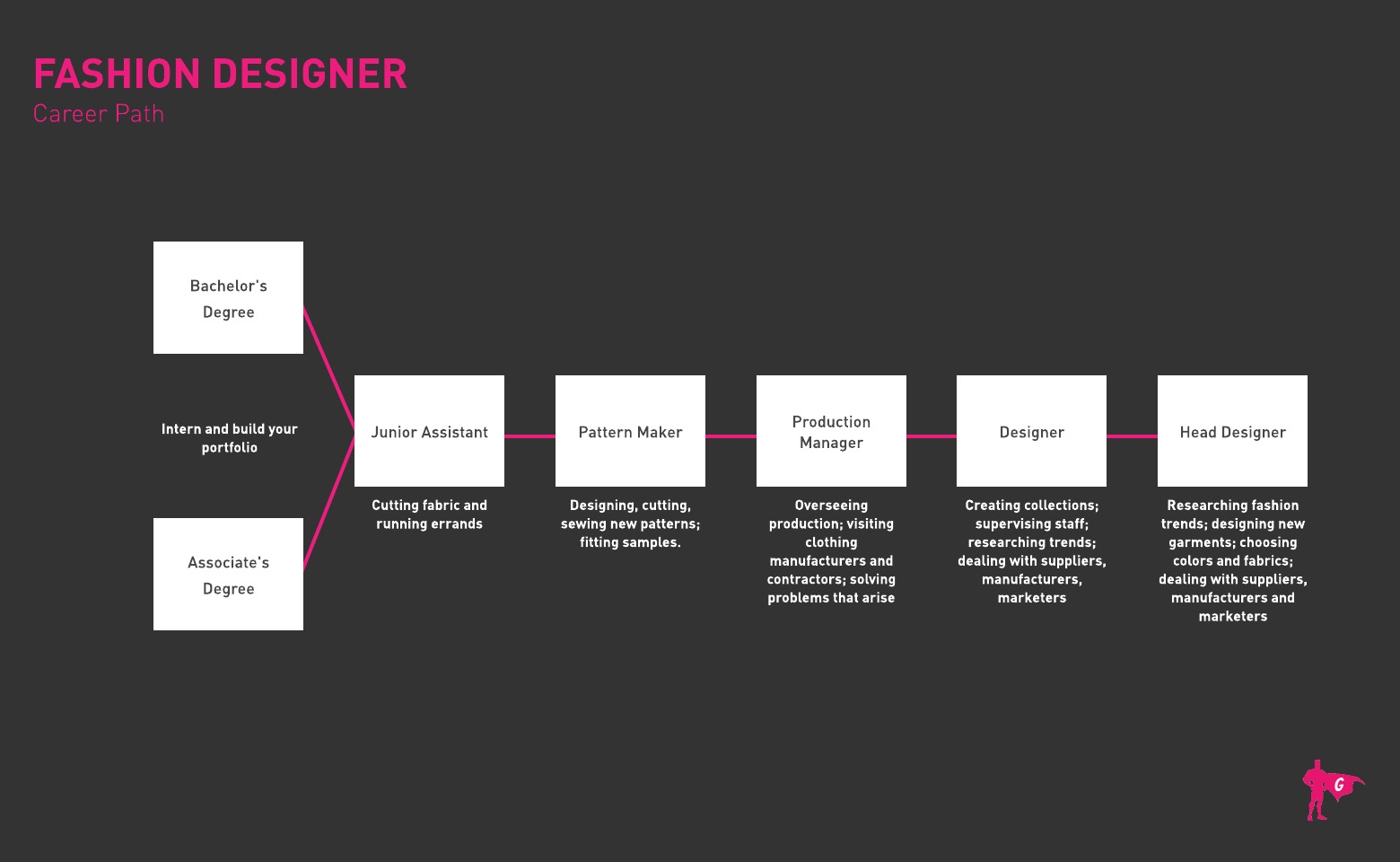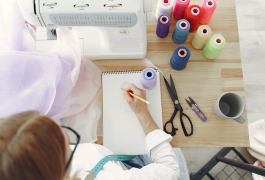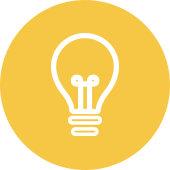Spotlights
Apparel Fashion Designer, Clothing Designer, Costume Designer, Dance Costume Designer, Designer, Historic Clothing and Costume Maker, Latex Fashions Designer, Product Developer, Fashion Illustrator, Fashion Stylist, Fashion Consultant, Fashion Creative Director
A fashion designer creates the patterns for clothing, accessories and footwear for a company. They use visual art to show their ideas and work with seamstresses or textile workers to help create their design.
- Seeing designs made into real world clothes and accessories.
- Being able to connect with a creative community.
- Given opportunity to travel.
A fashion designer can have many different tasks in a single day, or focus on a single task for several days. They may work for a larger apparel manufacturer or retail corporation. Some fashion designers are also able to self-employ and perform their work on a contract basis.
It can take an average of six months for designs to become reality. During this time, a fashion designer can expect to:
- Keep an eye on trends and guess which designs the public will enjoy, as well as visiting trade shows to review samples.
- With a team, or on their own, plan a theme for a larger collections and design the garments within it.
- Create designs with paper/pencil, and with Computer-Aided Design (CAD)
- Work with manufacturers to determine fabrics, styles, and colors for your designs.
- Work with marketing to sell designs to apparel stores or directly to consumers.
- Supervise the making of your final design.
After working on a design, either with paper or a computer, designers will sometimes sew their own prototype and use this experience to select the best fabrics for the garment’s use. They will determine the final textiles used when the product is manufactured.
Fashion Designers may be assigned specific areas: accessories, footwear, clothing, or costuming (for performing arts).
Soft Skills
- Strong written and oral communication skills.
- Creativity and problem solving.
- Attention to detail and well organized.
- Flexible and innovative in problem solving.
- Self-motivated.
Technical Skills
- Accounting and spreadsheet software such as Microsoft Excel for budgeting
- Computer Aided Design (CAD) such as AutoCAD, or pattern making software.
- Graphic design and photo editing skills (such as Adobe Photoshop)
- Understand of design techniques and blueprint creation for garments.
- Apparel Merchant
- Contract/Self-Employed
- Company Management
- Theatrical or Motion Picture Industry
- Apparel Manufacturing
Becoming a fashion designer can be done without a bachelor’s degree, those this can help build a network and connections for employment. This is a challenging industry to break into. You will need a strong portfolio, good connections, and the right opportunity to take advantage of. It is possible you will need to spend many years in a different graphic design, or similar career, before being hired as a graphic designer.
In order to be seen and known in this industry, it is likely you will have to work long and flexible hours, be willing to travel, and be willing to set your ego aside so you can take good criticism. If you do choose to attend school, you will likely be able to take and internship which you can use to help build connections and have a better chance of finding employment.
Like many consumable good industries, the fashion industry is incorporating more sustainable and environmentally friendly practices. There is also a movement to make fashion more inclusive, especially toward individuals of different sizes.
The market is also increasing its need for digital purchasing. Online sales are continuing to grow every year. Fashion is also more focused on athletic wear that can be worn in a variety of settings – athleisure.
- Drawing and visual arts.
- Playing dress-up
- Working in theater, especially costuming and backstage.
- Designing clothing for dolls or action figures.
- Technically a college degree or certification isn’t required, but ideally Fashion Designers should have some formal education from a Fashion Design school
- A bachelor’s program in Fashion Design can teach the skills you need plus allow you to build a strong portfolio
- A short certificate such as Cornell’s 4-course, online Fashion Design Management Certificate can also prove useful
- Since fashion is also a business, some students opt to pursue an MBA later, as well
- Ample On-the-Job training and work experience with project teams and studios may substitute or supplement some of the academics
- Standalone courses can also bolster your reputation! Fashionista’s 18 Online Fashion Courses Anyone Can Take is a great place to start looking
- Fashion Designers need to learn how to use a variety of software programs. Popular options include Adobe Illustrator, Autodesk Design Software, Wild Ginger Cameo, C-Design Fashion, Digital Fashion Pro, Corel Draw, Optitex, Browzwear, Clo 3D, and more!
- Take high school classes related to sewing, illustration, color theory, graphic design, and marketing
- History and math courses can come in handy later, too
- Sign up for community college classes or online courses to get a jump start on your formal, post K-12 education
- O*Net Online mentions that 25% of Fashion Designers have “some college, no degree” while 36% hold an associate’s and 24% have a bachelor’s
- Join local clubs or groups to exchange ideas, make friends, and keep your motivation high
- Start working on your professional portfolio early on, but keep it up-to-date and relevant
- Check out VelvetJobs' 18 Places To Find Paid Fashion Internships in the US. Indeed.com also offers a ton of internship openings, so sign up for alerts to get notified of new ones
- Check out fashion magazines from local libraries and photocopy articles of interest. You don’t necessarily need to buy or subscribe to magazines, unless you have the budget and space
- Read online articles, study photos on Instagram, and print out any you want to keep for reference
- Learn from the best in the business by following CHANEL, Ralph Lauren, Tom Ford, Yves Saint Laurent, Christian Louboutin, Marc Jacobs, Calvin Klein, VERSACE, DIOR, and more
- Watch YouTube fashion design channels, such as Vogue, to learn tips and trends
- Learn how to use popular fashion design software

- Read job postings very carefully. Screen for the qualifications section to ensure you meet all the minimum requirements before applying
- You’ll want a solid mix of practical experience and academic achievement to be competitive
- Obviously, if you’ve completed an internship, highlight that experience on your resume and include references, if asked
- Contact potential references in advance to ask if they’re willing to talk to hiring managers or to write letters of reference on your behalf
- If you don’t have a bachelor’s, be ready to demonstrate a strong portfolio along with practical self-taught skills and relevant work history
- Don’t be shy about telling your friends and colleagues that you’re looking for work and would like to hear any tips about openings
- Sign up for alerts from job portals such as ZipRecruiter, SimplyHired, Indeed, and Glassdoor
- Let your work speak for you! Fashion Design is a visual-oriented industry, so create an online portfolio to serve as a virtual calling card and show off your talents. Include details such as introductions, concept mood boards, technical drawings, and info about the designs and how you created each image
- Of course, you may also want to create a physical portfolio to carry with you to interviews
- During job interviews, be sure to dress the part! It’s also wise to study up on sample fashion interview questions so you don’t get blindsided with questions you didn’t expect
Websites
- Costume Designers Guild
- Council of Fashion Designers of America
- Fashion Group International
- Fashionista
- National Association of Schools of Art and Design
- The Underfashion Club
- Vogue
Books
- Fabric for Fashion: The Complete Guide, by Clive Hallett and Amanda Johnson
- Fashion Illustration & Design: Methods & Techniques for Achieving Professional Results, by Manuela Brambatti, Bruno Gianesi, et al.
- The Beginner's Fashion Design Studio: Easy Templates for Drawing Fashion Favorites, by Christopher Hart
- The Fashion Design Reference & Specification Book: Everything Fashion Designers Need to Know Every Day, by Jay Calderin and Laura Volpintesta
- Advertising/Promotions Managers
- Marketing Managers
- Interior Designers
- Desktop Publishing
- Fabric/Apparel Patternmakers
Becoming a Fashion Designer is a very challenging career path. Be sure you are prepared to have a different job, one that you enjoy, while you wait for the dream opportunity to come along. If being a fashion designer is the career you truly want to work in, keep your eyes open for any opportunities and be sure to keep you portfolio up to date at all times.
Newsfeed

Featured Jobs

Online Courses and Tools

Annual Salary Expectations
New workers start around $43K. Median pay is $79K per year. Highly experienced workers can earn around $120K.






